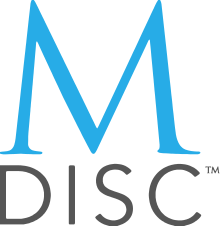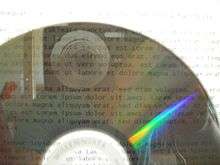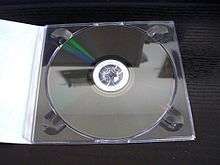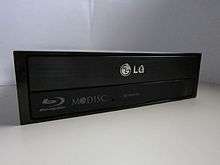M-DISC
 | |
| Media type | write once optical disc |
|---|---|
| Standard | DVD, Blu-ray disc |
| Developed by | Millenniata, Inc. |
| Dimensions | 12 cm |
| Usage | Archival storage |
| Extended from | DVD-R, BD-R |
M-DISC (Millennial Disc) is a write once optical disc technology introduced in 2009[1] and available as DVD and Blu-ray discs.
Overview


M-DISC's design is intended to provide greater archival media longevity.[2] Millenniata claims that properly stored M-DISC DVD recordings will last 1000 years.[3] While the exact properties of M-DISC are a trade secret,[4] the patents protecting the M-DISC technology assert that the data layer is a "glassy carbon" and that the material is substantially inert to oxidation and has a melting point between 200° and 1000 °C.[5][6]
The media were stress tested according to a procedure designed by Millenniata at a facility of the United States Department of Defense. The testing found that M-Disc DVDs are more durable than conventional DVDs. "The discs were subject to the following test conditions in the environmental chamber: 85°C, 85% relative humidity (conditions specified in ECMA-379) and full spectrum light".[7][8] However according to the French National Laboratory of Metrology and Testing at 90°C and 85% humidity the DVD+R with inorganic recording layer such as M-DISC show no longer lifetimes than conventional DVD±R.[9]
Conventional DVD-R and BD-R LTH (Low To High) use recording layers of organic dye and separate reflective layers.[10] Standard (HTL) BD-R and BD-R/DL (except LTH BD-R[11]) typically use inorganic data layers, but continue using a reflective layer. M-DISC BD-R has no reflective layer.[12] M-DISC uses a single inorganic recording layer, which is substantially inert to oxygen, but requires a higher-powered laser. M-DISC DVD does not require the reflective layer. Thus, both the M-DISC and inorganic BD-R physically alter the recording layer, burning a permanent hole in the material. Besides physical damage, failure of the reflective layer, followed closely by degradation of the data layer, are the primary failure modes of all optically recordable disks.
Recorded discs are readable in conventional drives. Available recording capacities are similar to other optical media from 4.7GB DVD-R to 25GB, 50GB BD-R and 100GB BD-XL. In first DVD and Blu-ray M-Discs there was difficulty distinguishing the writable side of the disc, so they added color to distinguish the sides and make it look like the coloring on standard DVD or Blu-ray media.
LG Electronics, ASUS and Lite-On [13] produce drives that can record M-DISC media. Ritek produces M-DISC Blu-ray disc media, sold under the Imation, Ritek and M-DISC brands. Verbatim produces co-branded discs, marketed as the "Verbatim M-Disc".[14][15]
History
M-DISC developer Millenniata, Inc. was co-founded by Brigham Young University professors Barry Lunt[16] and Matthew Linford,[17] along with CEO Henry O'Connell and CTO Doug Hansen.[18] The company was incorporated on May 13, 2010 in American Fork, Utah.[1]
References
- 1 2 "Springville company introduces new DVD to protect data for a thousand years or more"Daily Herald. Retrieved 17 July 2009.
- ↑ "Final Report for Millenniata DVD Testing August 2009-October 2009", Naval Air Warfare Center Weapons Division. Retrieved 10 November 2009.
- ↑ Front Page
- ↑ mDisc Review
- ↑ "Optical data storage media containing substantially inert low melting temperature data layer US 8389095 B2", Patent US 8389095. Retrieved 25 September 2014.
- ↑ "Long-term digital data storage US 7613869 B2", Patent US 7613869. Retrieved 25 September 2014.
- ↑ "75 page breakdown of the D.O.D.'s findings"
- ↑ "2 page summary of DOD's findings"
- ↑ "5.4. SUMMARY OF THE TESTS ON ACCELERATED AGING"
- ↑ See CD-R for an overview
- ↑ "Not all Blu-ray discs are created equal, but does BD-R quality matter?"
- ↑ "M-Disc optical media reviewed: Your data, good for a thousand years"
- ↑ "Lite-On eBAU108 Product Information"Lite-On Corp. Retrieved 19 February 2014.
- ↑ "Millenniata Archiving Blu-ray M-Disc Available in Spring 2013" StorageNewsletter.com. Retrieved 10 January 2013.
- ↑ "M-Disc's list of devices that can write
- ↑ Barry Lunt Website
- ↑ Matthew Linford Website
- ↑ Douglas Hansen Biography
External links
| Wikimedia Commons has media related to Millennial Disc. |
